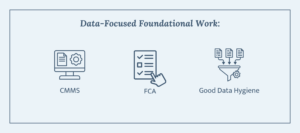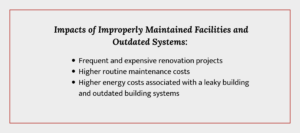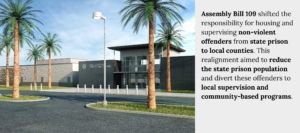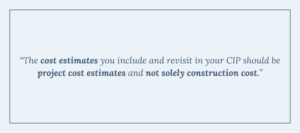
Developing Smarter Capital Improvement Plans: Balancing Facts, Funding, and the Future
Developing and Managing Capital Improvement Plans
With over 25 years of experience in strategic program management and public facilities planning, I’ve had the opportunity to work on both the public sector and client side of capital improvement planning. Before joining CGL Companies, I served as the Deputy Director at the County of San Diego’s Department of General Services where my team in the Asset Management Division was responsible for managing the County’s Capital Improvement Plan (CIP) for most vertical construction. While the process for developing and managing a CIP varies across organizations, there are some principles that apply universally and some concepts that can help with obtaining plan approval.
For the purposes of this discussion, the CIP is “the Plan” (distinct from capital project implementation), and the components will typically include an evaluation of your organization’s long term capital needs, prioritization of those needs, and high-level cost and schedule estimates to determine funding requirements and sources.
The principles and ideas in today’s blog post span the entirety of the CIP planning cycle; from the foundational information that feeds into the CIP, to the development of the Plan, to investing in preliminary work that can streamline the preparation of the CIP and subsequent project implementation, to successful CIP presentation and communication.
Let’s get started.
Starting With a Solid Foundation

As an owner or program manager overseeing the CIP, you have multiple audiences and stakeholders seeking to influence plan priorities. These competing interests can be politicians, end user departments or the community you serve. To mitigate the chance of any one voice or stakeholder group having an outsized influence over CIP priorities, it’s crucial that the prioritization of projects in the plan be based in fact; therefore, some data-focused foundational work is required. This may include:
- Ensuring your organization has a modern and functional CMMS/CAFM. You should have an accurate record of the maintenance demands and operational costs for every asset in your inventory. Anecdotal information from maintenance staff is incredibly valuable, but it becomes more powerful when supported by workorder data and an accurate accounting of maintenance expenditures.
- Conducting Facility Condition Assessments. These surveys facilitate an in-depth understanding of your assets and the deficiencies that need to be addressed. Both the anecdotal details on your equipment and building systems as well as the metrics provided in the FCA (e.g., the Facility Condition Index) will help in establishing CIP priorities.
- Maintaining good data hygiene. Owners frequently have limited resources and may not be able to assign staff to maintain the facility database, noting when deficiencies have been corrected. Assigning resources and investing in good data hygiene gives you confidence in the outputs from your information systems, which translates to confidence in your CIP. Good data in = good data out.
Developing the Capital Improvement Plan
To the extent possible, the prioritization of projects in the CIP should be objective and apolitical. This requires some type of evaluation framework for comparing projects and communicating the impact of projects relative to one another. Your framework should consider the following:
- CIP Evaluation Criteria. Try to avoid establishing criteria that can be easily manipulated, and which could result in a CIP prioritization that may not accurately reflect the real needs of the organization. Decision makers who approve capital initiatives can certainly be swayed by constituent demands, but they are generally more comfortable starting from a position grounded in data and facts. We often hear officials tout their dedication to “data-driven decision-making.” As the CIP manager, you want to be confident in your assurances to your approving body that the materials you are presenting are accurate and objective, and then let the chips fall where they may.
- Regulatory and Code Compliance. Planners and managers have an obligation to ensure that the facilities in our portfolios are safe and accessible. Identifying whether the organization is meeting mandates and determining the level of compliance with current standards are essential quantitative criteria for prioritizing projects within your CIP. Including these criteria in the evaluation process is good practice from a risk management perspective as it illustrates the organization’s commitment to safety and accessibility.
- Ongoing Operational Costs (including both facility operations and staffing). Older facilities typically cost more to maintain with more frequent and expensive renovation projects, higher routine maintenance costs, and higher energy costs associated with a leaky building and outdated building systems. On the staffing side, a new facility could have a higher or lower staffing requirement than an existing facility it replaces influenced by the size of the proposed facility, the use of technology to enhance efficiency or a plan to introduce a new operational model. The bottom line is that, when factoring in operational costs alone, sometimes it will seem foolish not to budget for a capital project.

Older buildings need to keep adapting to evolving operational needs and can become less staff efficient over time. A new facility creates an opportunity for a design refresh and improved staffing efficiencies. Using $106,382 as the average annual salary of a federal government employee and a 1.4 multiplier to account for their true cost, about $1 million can be saved annually in today’s dollars for every seven staff positions no longer needed.
- Criteria Measuring Quantitative Impacts. A public facility, unless it is an historic restoration or renovation, is not important in and of itself. It’s more appropriate to view a new facility as a vehicle for efficiently delivering services to customers – whether it’s a public-facing building, a park, a secure institution, or infrastructure. When it comes to prioritizing your CIP, employ criteria that measure the quantitative impacts of a new facility within this service delivery context. Use the client department’s service areas or their system for classifying customers to figure out how many people the new facility will serve and what kind of impact it will have.
- …But Don’t Forget Criteria Measuring Qualitative Impacts. Emphasizing the importance of quantitative impacts isn’t to say that qualitative impacts should be discounted entirely. A facility in comparatively decent condition may might still need to be replaced or renovated because it does not accommodate the preferred operational model. Further, the quality of the environment can be a major contributor to customer and employee satisfaction. A newer building, particularly one using people-oriented design principles, will be a more pleasant place to visit and work. With the employee recruitment and retention challenges we’re facing in the public sector, this is an important criterion to include in your CIP evaluation. Another possible qualitative consideration is to assess how the proposed project aligns with your parent organization’s vision and strategic initiatives.
Ultimately, you want to be sure that each proposed project on the CIP undergoes the same rigorous evaluation and that the resulting prioritization is thoughtful and grounded in fact.
Planning and Phasing
If your organization allows it, spending money on planning initiatives can improve your CIP and streamline subsequent project implementation.

If your organization and budget allows for it, instituting planning initiatives like master plans can greatly improve your CIP efforts by helping to streamline and prioritize capital projects. Pictured: The Ohio Correctional System Master Plan.
A prime example is commissioning facility master plans for an individual department or system. If you anticipate building more than one of a particular facility type, the master plan could also include architectural prototypes for site adaptation. Having detailed information derived from a master plan to plug into the CIP is helpful, especially when it comes to providing preliminary project cost estimates with a higher level of accuracy. The internal priorities from department plans can and should translate over to the CIP priorities such that a high priority master plan project is ranked accordingly on the parent organization’s CIP.
Phasing projects on the CIP is another approach that can be successful if your fiscal policies and preferred delivery method allow for it. A single CIP line item might have a site acquisition phase or programming and design phase, separate from and in advance of construction funding approval. This “seed” money strategy can create real momentum for a project.
CIP Program Management
The CIP is often a standalone plan that feeds into an organization’s budget process. Individual projects from the CIP move forward into the capital budget once funding has been secured. This is where the discipline and objectivity that goes into developing the CIP and establishing project priorities may need to take a back seat to leveraging funding opportunities.

Pictured: The John Latorraca Center (Merced County, Calif.). The client, Merced County, required an assessment to help address the influx of inmates in response to Assembly Bill 109. CGL assisted the County in responding to the SB 863 funding process in the State of California that allotted $40 million for medium sized counties such as Merced to use as a replacement of the county jail, to expand programs and services, and increase medical care. Click on the image above to learn more.
For example, your state legislature may create a funding source for certain initiatives, as California did with the passage of AB109 – Public Safety Realignment. This program provided several hundred million dollars (ultimately over $1B) to counties to construct beds that would enable the shift of certain lower-level offenders from state custody to local detention facilities. Passing on such an opportunity because it doesn’t perfectly align with CIP priorities would be nonsensical. There are other examples of leveraged funding opportunities, to include sustainability programs sponsored by utility providers or partnerships with other nonprofits or public agencies (e.g., co-locating a law enforcement facility with a fire protection district fire station). These opportunities can be rare and a bit more complicated, but worth adjusting your CIP priorities for.
Evaluate and Simplify Processes
Organizations, particularly public sector entities, have adopted policies, procedures, and processes that we follow “because that’s the way it’s always been done.” When it comes to managing your CIP, it’s worthwhile to examine how the plan gets developed and brought forward for approval. You may find that over time, the process and deliverables have become unwieldy and unnecessarily complicated.

While with the San Diego Sheriff’s Office, I was involved in the development of the Las Colinas Women’s Detention and Reentry Facility, where we applied many of the CIP recommendations and tactics described in this post.
This was the case in San Diego County, where efforts to appease internal client departments led to a CIP with pages and pages of projects that were “aspirational” and unlikely to ever move up in priority. The elected board expressed frustration with a process that offered them minimal opportunity to provide input into the plan during development. In response, we overhauled our CIP process and cleaned up the associated deliverables. This process reengineering enhanced plan transparency and greatly improved communications with plan approvers. Alongside presentation of the revamped CIP, we sought approval for a policy revision to adopt the changes to the process and deliverables.
On the topic of plan deliverables, simplicity is important. Your control document may have innumerable columns and exhaustive data, but that probably won’t serve you well when it comes to communicating the plan to your stakeholders. It’s worthwhile to create a streamlined and intuitive version of the CIP geared to the layperson’s understanding.
Which brings me to the universal dread that many of us experience when publishing project cost estimates in a planning-level document. The CIP is a strategic and multi-year plan, so projects that stay on the plan year-over-year will have an estimated cost that should be updated annually to reflect changing economic conditions. Failing to routinely update these estimates can result in approvers questioning a dramatic and unpalatable increase when a project eventually becomes a high priority and is recommended for implementation. Invest in estimating services or work closely with your capital project implementation team who should have good data based on current costs. The cost estimates you include and revisit in your CIP should be project cost estimates and not solely construction cost. This advice also applies to long-term operating costs. Updating those costs within your CIP to reflect current maintenance, utility, and staffing costs is important for decision-makers who will be weighing the pros and cons of the CIP priorities and as they approve funding for project implementation.

Key Takeaways for Successfully Managing Capital Improvement Plans
Creating and managing a Capital Improvement Plan is a complex but essential process for any organization, particularly when dealing with public safety or justice facilities. From gathering accurate data and setting objective project priorities to engaging stakeholders and securing funding, each step requires careful consideration. Align the CIP with your organization’s service delivery needs and be sure that the focus on the customer is apparent in the CIP deliverables, which should be clear, concise and factual. If you find yourself needing more support or guidance on creating and managing a CIP, there are resources available to help you achieve a successful, impactful CIP that serves the needs of your community.
